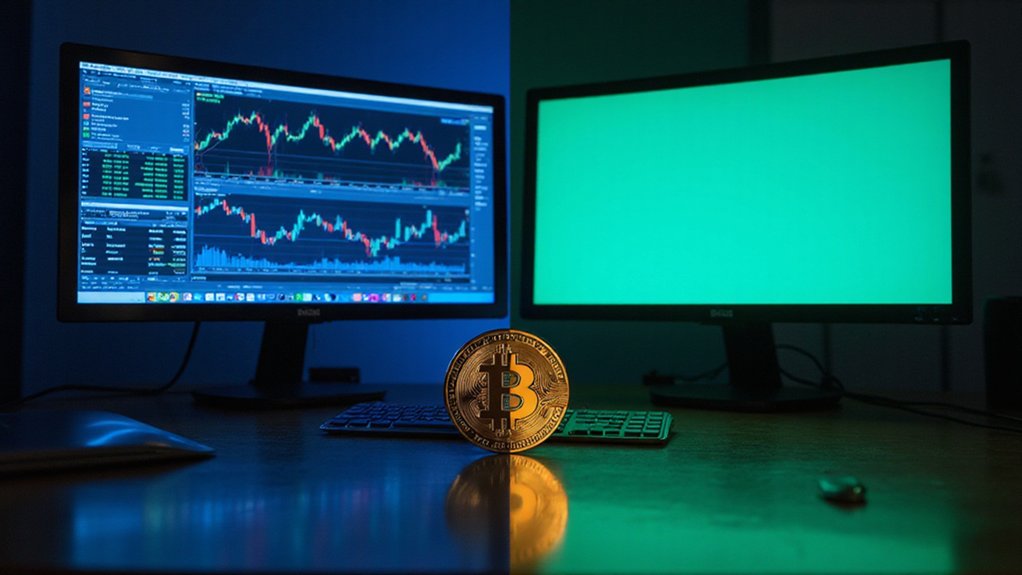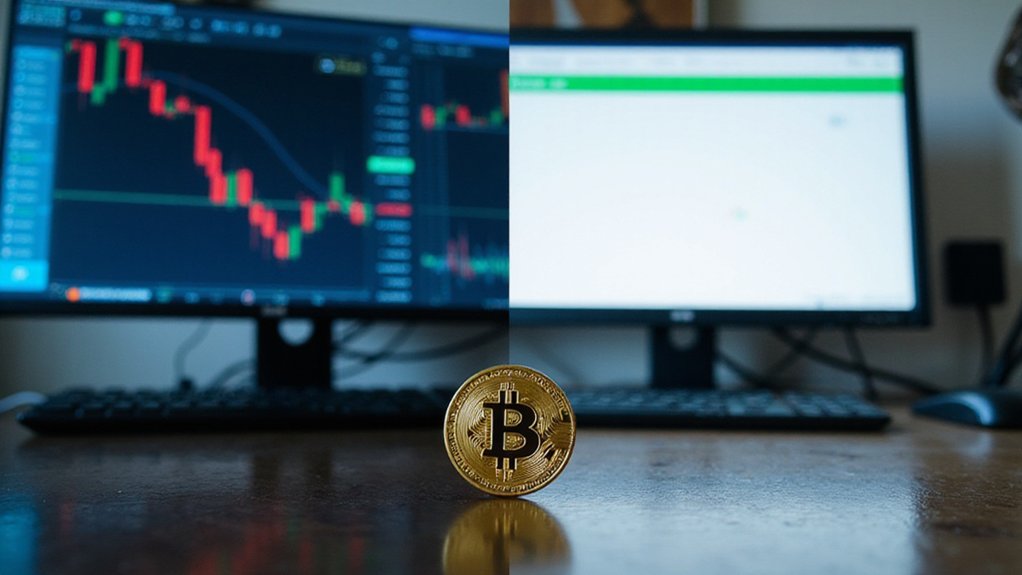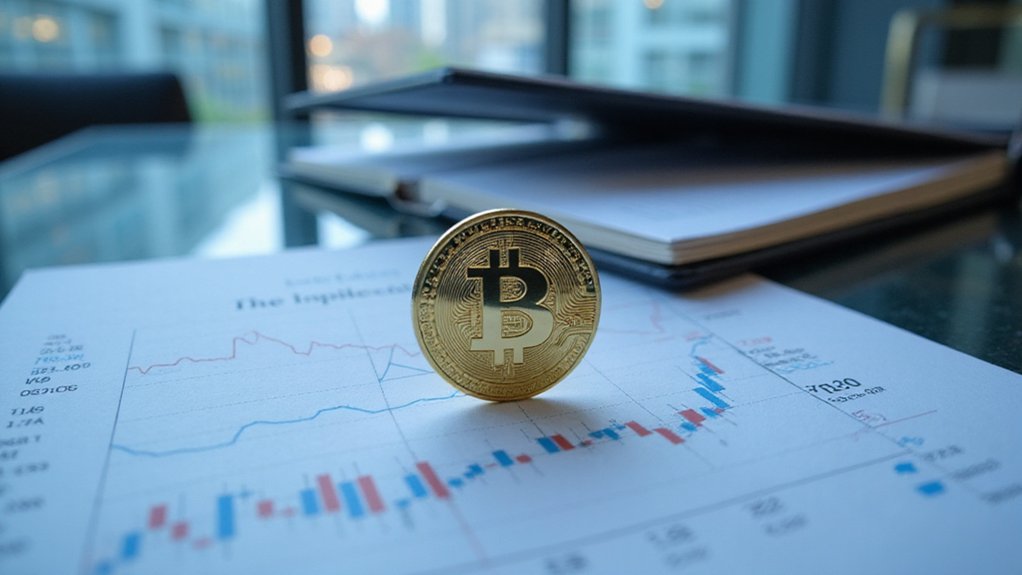Bitfinex caters to seasoned traders seeking advanced tools, margin trading, and diverse altcoins at competitive fees (starting at 0.1% maker/0.2% taker versus Coinbase‘s 0.5%). Meanwhile, Coinbase prioritizes user-friendliness and security with a curated asset selection, albeit at premium rates. The choice hinges on one’s trading sophistication—Bitfinex for those pursuing complex strategies and asymmetric returns, Coinbase for newcomers valuing simplicity. The platform most aligned with your risk appetite ultimately determines profitability.

The cryptocurrency exchange landscape presents traders with a rather stark dichotomy between platforms catering to disparate segments of the market—a reality perfectly exemplified by Bitfinex and Coinbase.
The former positions itself squarely in the domain of the experienced trader, offering a sophisticated arsenal of trading tools, while the latter has built its reputation on user-friendly interfaces that welcome neophytes into the cryptosphere with open arms (albeit at a premium).
When examining fee structures—that unavoidable friction in any trader’s calculus—Bitfinex emerges with a distinct advantage.
Fees represent trading’s inevitable tax, where Bitfinex offers traders a compelling edge over its competitors.
Its maker-taker model begins at a relatively modest 0.1% and 0.2% respectively, whereas Coinbase extracts a more substantial toll starting at 0.5%.
Bitfinex offers significantly lower fees than Coinbase, with maker fees at just 0.10% compared to Coinbase’s 2.00%.
High-volume traders, in particular, may find Bitfinex’s tiered discount structure increasingly appealing as their trading activity scales.
Asset diversity presents another point of divergence.
Bitfinex supports an extensive array of cryptocurrencies, including more obscure altcoins that might appeal to speculative traders seeking asymmetric returns.
Coinbase, conversely, maintains a more curated selection, emphasizing established cryptocurrencies with proven track records—a more conservative approach that nonetheless limits trading opportunities.
Perhaps the most significant distinction lies in trading capabilities.
Bitfinex caters to the sophisticated trader with margin trading, leverage options, and advanced order types that enable complex strategies.
Coinbase, by contrast, focuses primarily on spot trading, eschewing the derivatives and leverage that can amplify both returns and risks.
For yield-seeking traders, Bitfinex offers more diverse earning opportunities through its Lending Pro program, presenting variable rates across numerous assets. These features mirror solutions offered by platforms like YouHodler, which provides up to 20% annually on yield accounts with weekly payouts.
While potentially lucrative, these returns fluctuate with market conditions, introducing an element of unpredictability absent from Coinbase’s more limited but straightforward staking options.
Recent events have highlighted Coinbase’s commitment to security, as the exchange demonstrated industry-leading practices in handling a major cyberattack that affected approximately 1% of its users.
Ultimately, the question of superiority between these exchanges hinges on trader sophistication.
Those seeking lower fees, advanced trading features, and broader asset selection will gravitate toward Bitfinex, while traders prioritizing institutional-grade security, regulatory clarity, and simplicity may find Coinbase’s premium worth paying.
Frequently Asked Questions
How Secure Are Bitfinex and Coinbase Against Hacking?
Both exchanges employ robust security architectures, though with distinct emphases.
Bitfinex leverages cold storage for 99.5% of assets, multisignature protocols, and hardware-based two-factor authentication—a formidable defense against digital marauders.
Coinbase, meanwhile, complements its security apparatus with FDIC insurance (up to $250,000 for USD holdings) and regulatory compliance.
Neither fortress is impregnable (what digital stronghold truly is?), but both have implemented multi-layered defenses that render successful attacks increasingly improbable.
What Customer Support Options Do Both Exchanges Offer?
Coinbase offers a veritable smorgasbord of support options—24/7 assistance via email, phone, and live chat—complemented by multilingual capabilities and an active social media presence.
Bitfinex, meanwhile, takes a more austere approach, relying primarily on a ticket system (hardly the pinnacle of urgency) and community forums.
The contrast is stark: Coinbase’s thorough, round-the-clock support versus Bitfinex’s more limited, measured response framework—a distinction that often translates to markedly different user experiences.
Can I Use Both Platforms in My Country?
The availability of Bitfinex and Coinbase depends entirely on your specific location.
Both exchanges operate globally but with varying restrictions—Bitfinex explicitly excludes countries like Bangladesh, Bolivia, Ecuador, and Kyrgyzstan, while Coinbase maintains its own set of geographical limitations.
The determining factor hinges on your country’s regulatory environment, which can shift with alarming regularity.
To confirm accessibility, one should consult each platform’s current terms of service rather than relying on potentially outdated information.
How Do Withdrawal Times Compare Between the Exchanges?
Bitfinex typically processes cryptocurrency withdrawals faster than Coinbase, often within minutes versus Coinbase’s hour-plus timeframes.
This disparity stems from Coinbase’s more rigorous compliance checks—security that, while admirable, can test one’s patience.
For fiat transfers, Coinbase generally requires 1-3 business days, while Bitfinex’s wire transfers demand similar patience.
Both platforms remain at the mercy of blockchain congestion and banking systems, rendering their “estimated” timeframes somewhat aspirational rather than contractual.
What Mobile App Features Are Available on Each Platform?
Both exchanges offer iOS and Android mobile apps with divergent feature sets reflecting their overall market positioning.
Bitfinex caters to the trading cognoscenti with advanced order types, customizable charts, and sophisticated features like margin capabilities and derivatives trading.
Coinbase, meanwhile, presents a more accessible interface—beguilingly simple for newcomers—focusing on straightforward buying/selling functionality, real-time price updates, and educational resources.
Both implement requisite security measures, though Bitfinex’s complexity might mystify those not versed in trading’s arcane arts.









